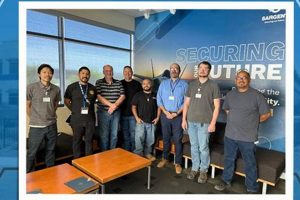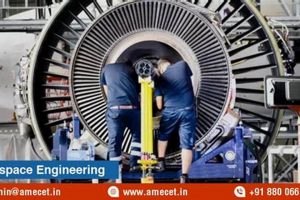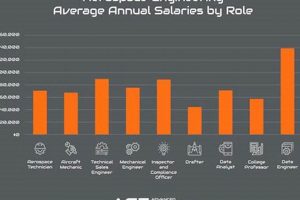Career opportunities for individuals with degrees in aerospace engineering encompass a broad spectrum of roles within the aviation, space exploration, and defense sectors. These positions involve designing, developing, testing, and maintaining aircraft, spacecraft, satellites, and related systems. Examples include roles such as aerospace engineer, design engineer, propulsion engineer, and structural engineer.
The availability of such roles is vital to technological advancement and national security. These careers drive innovation in air and space travel, contributing to scientific discoveries and economic growth. Historically, the demand for professionals in this field has fluctuated with governmental investment in research and development, as well as the overall health of the commercial aviation industry.
The subsequent sections will detail specific roles, required skills, potential employers, and career advancement pathways accessible to graduates possessing relevant qualifications. Further discussion will also address factors impacting employment prospects and strategies for career success.
Guidance for Aerospace Engineering Graduates Seeking Employment
This section provides actionable advice for aerospace engineering majors preparing for or actively engaged in a job search. These tips are designed to improve prospects in a competitive job market.
Tip 1: Cultivate a Strong Technical Foundation: Emphasize proficiency in core aerospace engineering principles such as aerodynamics, propulsion, structures, and control systems. A solid understanding of these fundamentals is essential for success in most roles.
Tip 2: Acquire Specialized Software Skills: Develop expertise in industry-standard software packages like MATLAB, ANSYS, SolidWorks, or similar tools. Familiarity with these programs is frequently a prerequisite for employment.
Tip 3: Seek Internships and Research Opportunities: Gain practical experience through internships at aerospace companies, research labs, or government agencies. These experiences provide valuable hands-on skills and networking opportunities.
Tip 4: Highlight Relevant Projects: Showcase relevant projects undertaken during academic coursework or extracurricular activities. Detail the scope, methodologies, and outcomes of these projects in a portfolio or resume.
Tip 5: Network Strategically: Attend industry conferences, career fairs, and networking events to connect with professionals in the aerospace field. Building relationships can open doors to potential job opportunities.
Tip 6: Tailor Resumes and Cover Letters: Customize resumes and cover letters to match the specific requirements of each job application. Highlight the skills and experiences that are most relevant to the role.
Tip 7: Prepare Thoroughly for Interviews: Practice answering common interview questions and be prepared to discuss technical skills, projects, and career goals. Research the company and demonstrate genuine interest in the organization.
Implementing these recommendations can significantly enhance a graduate’s competitiveness within the job market, leading to improved career prospects and long-term professional success.
The following sections will further explore the specifics of career paths, potential employers, and strategies for career advancement within the aerospace engineering industry.
1. Design and Development
Design and development represents a cornerstone of opportunities for graduates in aerospace engineering, directly impacting innovation and technological advancement within the sector. This area encompasses a wide range of roles focused on creating, refining, and implementing aerospace systems.
- Conceptual Design
This facet involves creating initial designs and specifications for aircraft, spacecraft, and related components. Engineers analyze requirements, explore different concepts, and perform trade studies to determine the most viable solutions. A conceptual design engineer might, for instance, develop preliminary layouts for a new hypersonic vehicle, considering factors such as aerodynamics, propulsion, and materials. This work is fundamental to setting the direction for subsequent design stages.
- Detailed Design
Detailed design builds upon the conceptual framework, focusing on precise specifications, component selection, and integration. Engineers use CAD/CAM software to create detailed models, perform structural analysis, and optimize designs for performance and manufacturability. An example would be designing the internal structure of an aircraft wing, ensuring it meets strength and weight requirements while accommodating fuel tanks and control systems. This phase is crucial for ensuring the feasibility and reliability of the final product.
- Systems Integration
This aspect involves integrating various subsystems into a cohesive and functional aerospace system. Engineers work to ensure that components such as engines, avionics, and control systems operate seamlessly together. Systems integration engineers might be responsible for integrating a new radar system into an existing aircraft, ensuring compatibility with other avionics and minimizing interference. This integration is vital for overall system performance and safety.
- Prototyping and Testing
Prototyping and testing involve building and evaluating physical prototypes to validate designs and identify potential issues. Engineers conduct wind tunnel tests, flight tests, and structural tests to assess performance, stability, and safety. For instance, engineers might build a scale model of an aircraft and test it in a wind tunnel to measure lift and drag characteristics. This iterative process allows for design refinements before production.
These facets of design and development collectively represent significant career avenues for aerospace engineering graduates. The ability to contribute to the creation of advanced aerospace systems is a driving force for many in this field, leading to roles that are both technically challenging and profoundly impactful.
2. Research and Innovation
Research and innovation constitute a critical domain for aerospace engineering graduates, fueling advancements in technology and driving the future of air and space travel. These activities are essential for maintaining competitiveness and pushing the boundaries of what is currently achievable.
- Advanced Materials Research
This facet focuses on developing and testing new materials with enhanced properties such as increased strength-to-weight ratio, temperature resistance, and durability. Examples include the development of composite materials, nanomaterials, and high-temperature alloys. The outcome of this research directly impacts the design and performance of aircraft and spacecraft, leading to positions in materials engineering, research science, and structural analysis for aerospace companies and research institutions.
- Aerodynamics and Fluid Dynamics Research
This involves studying airflow patterns and forces acting on aerospace vehicles, aiming to improve aerodynamic efficiency and reduce drag. Computational Fluid Dynamics (CFD) and wind tunnel testing are key tools. Research outcomes can lead to optimized aircraft designs, improved fuel efficiency, and enhanced maneuverability. Career paths include aerodynamics engineer, CFD analyst, and experimental fluid dynamicist roles within aerospace manufacturers and government research labs.
- Propulsion Systems Research
This area concentrates on developing advanced propulsion technologies, including jet engines, rocket engines, and electric propulsion systems. Research focuses on improving fuel efficiency, reducing emissions, and increasing thrust-to-weight ratios. Graduates may find opportunities as propulsion engineers, combustion specialists, or rocket engine designers at aerospace companies, NASA, and defense contractors.
- Autonomous Systems and Robotics Research
This involves developing autonomous control systems and robotics for aerospace applications, such as unmanned aerial vehicles (UAVs), autonomous spacecraft, and robotic assembly systems. Research includes sensor development, algorithm design, and artificial intelligence integration. Relevant job roles include robotics engineers, control systems engineers, and UAV developers employed by aerospace companies, research institutions, and defense agencies.
These research and innovation activities are integral to the aerospace field, providing a foundation for future advancements and creating diverse career opportunities for aerospace engineering graduates. These roles are instrumental in shaping the next generation of air and space transportation systems and contribute significantly to scientific progress.
3. Testing and Analysis
Testing and analysis form a critical component of career opportunities for aerospace engineering graduates. These activities are essential for ensuring the safety, reliability, and performance of aircraft, spacecraft, and related systems. Errors in design or manufacturing can have catastrophic consequences, making rigorous testing and analysis indispensable. For instance, finite element analysis (FEA) is routinely employed to simulate stress distributions within aircraft structures, identifying potential weak points before physical prototypes are even constructed. Similarly, wind tunnel testing is used to validate aerodynamic performance and stability characteristics. The failure to adequately test and analyze designs can lead to structural failures, control system malfunctions, and other critical issues, highlighting the significance of these roles.
The practical application of testing and analysis extends beyond initial design validation. It encompasses ongoing monitoring of aircraft and spacecraft in service, failure investigations, and the development of improved testing methodologies. For example, non-destructive testing (NDT) techniques, such as ultrasonic inspection and radiography, are used to detect hidden cracks and defects in aircraft components during routine maintenance checks. These techniques enable engineers to identify and address potential problems before they lead to in-flight failures. Furthermore, data analysis of flight recorder information allows for the identification of trends and anomalies that may indicate underlying system issues. Testing and analysis positions often require a strong understanding of engineering principles, data analysis techniques, and relevant industry standards.
In summary, testing and analysis are integral to the lifecycle of aerospace systems, creating numerous employment opportunities for aerospace engineering majors. These roles are essential for ensuring the safety, reliability, and performance of aircraft and spacecraft, and require a combination of technical expertise, analytical skills, and attention to detail. The challenges within this domain involve developing and implementing ever-more sophisticated testing methodologies to address the increasing complexity of modern aerospace systems. These career paths are fundamental to the broader theme of advancing aerospace technology and ensuring the continued safety of air and space travel.
4. Manufacturing and Production
Manufacturing and production constitute a substantial sector within the career landscape accessible to aerospace engineering majors. These activities translate designs and prototypes into functional aerospace vehicles and components. Opportunities within this domain span from initial fabrication to final assembly and quality control, demanding a blend of theoretical knowledge and practical application. The efficiency and precision of manufacturing processes directly impact the performance, safety, and cost-effectiveness of aerospace products. For instance, the implementation of advanced composite manufacturing techniques for aircraft wings can significantly reduce weight, leading to improved fuel efficiency. The demand for qualified aerospace engineers in manufacturing roles remains consistently high, driven by the continuous development of new aircraft, spacecraft, and defense systems.
Aerospace engineers in manufacturing settings are involved in a range of tasks, including process optimization, tooling design, and material selection. They work closely with technicians and skilled tradespeople to ensure that manufacturing processes adhere to stringent quality standards and regulatory requirements. For example, engineers may be responsible for overseeing the production of turbine blades for jet engines, ensuring that they meet precise dimensional tolerances and material specifications. Furthermore, they contribute to the implementation of lean manufacturing principles to improve efficiency and reduce waste. The use of automated manufacturing systems, such as robotic assembly lines, is also increasingly prevalent in the aerospace industry, requiring engineers with expertise in robotics and automation.
In summary, manufacturing and production represent a significant and vital area for aerospace engineering graduates. These roles are essential for transforming theoretical designs into tangible aerospace products, contributing to the overall advancement and competitiveness of the industry. The integration of advanced manufacturing technologies and the emphasis on quality control create a challenging and rewarding career path for those with the requisite skills and knowledge. As aerospace technology continues to evolve, the demand for skilled engineers in manufacturing and production will remain strong, ensuring the continued success of the sector.
5. Management and Leadership
Opportunities in management and leadership within aerospace engineering are intrinsically linked to the trajectory of experienced professionals. As engineers gain technical expertise and demonstrate project success, pathways to leadership roles become increasingly accessible. Management roles require a shift from direct technical contributions to overseeing projects, coordinating teams, and ensuring alignment with organizational objectives. Effective leadership is crucial in this context, providing vision, motivation, and strategic direction. The successful implementation of a new aircraft design, for example, necessitates strong leadership to navigate the complexities of development, testing, and certification, exemplifying the direct impact of management and leadership on project outcomes.
Management and leadership competencies extend beyond purely technical skills. They encompass effective communication, decision-making, conflict resolution, and resource allocation. Aerospace engineering projects often involve multidisciplinary teams, requiring managers to effectively integrate diverse skill sets and perspectives. The development of a new satellite system, for instance, involves collaboration between engineers specializing in propulsion, communications, structural design, and software development. A competent leader must facilitate effective communication among these teams, ensuring that the project progresses smoothly and meets performance requirements. Strong leadership is vital in navigating technical challenges, managing budgets, and adhering to schedules.
In summary, management and leadership roles represent a significant career progression for aerospace engineering professionals. The effective application of leadership principles is paramount to achieving project success, fostering innovation, and ensuring the continued advancement of aerospace technology. These roles require a blend of technical expertise, interpersonal skills, and strategic thinking, contributing to the efficient and effective operation of organizations within the aerospace sector. Challenges involve adapting to evolving technologies, managing increasingly complex projects, and fostering a culture of innovation and continuous improvement.
Frequently Asked Questions Regarding Career Opportunities for Aerospace Engineering Majors
This section addresses common inquiries and misconceptions about career prospects for graduates with degrees in aerospace engineering. The information presented aims to provide clarity and insight into potential career paths and associated considerations.
Question 1: What are the typical entry-level positions available to aerospace engineering graduates?
Entry-level positions commonly include roles such as design engineer, test engineer, manufacturing engineer, and systems engineer. These roles generally involve supporting senior engineers in design, analysis, testing, and production activities.
Question 2: Which industries commonly employ aerospace engineering graduates?
Aerospace graduates are employed in various sectors, including aerospace manufacturing, defense, government agencies (such as NASA and the FAA), and research institutions. Opportunities may also exist in related fields like automotive and energy.
Question 3: Is advanced education (e.g., a master’s or doctoral degree) necessary for career advancement in aerospace engineering?
While not always mandatory, advanced degrees can significantly enhance career prospects, particularly for research-oriented positions and leadership roles. A graduate degree provides opportunities for specialization and deeper technical knowledge.
Question 4: What are the key skills and competencies sought by employers of aerospace engineering graduates?
Employers typically seek candidates with strong analytical skills, problem-solving abilities, proficiency in relevant software (e.g., CAD, FEA), understanding of aerospace principles, and effective communication skills. Teamwork and project management skills are also highly valued.
Question 5: How does the current economic climate affect job prospects for aerospace engineering graduates?
Economic fluctuations and government spending priorities can influence the demand for aerospace engineers. Periods of economic growth and increased defense spending typically lead to greater job opportunities. Monitoring industry trends and governmental policies is advisable.
Question 6: What strategies can aerospace engineering graduates employ to enhance their job search efforts?
Strategies include networking with industry professionals, participating in internships and research projects, tailoring resumes and cover letters to specific job requirements, and developing a strong online presence. Preparation for technical interviews is also crucial.
In summary, career opportunities for aerospace engineering majors are diverse and influenced by several factors. Proactive career planning and continuous skill development are essential for success in this competitive field.
The subsequent section will provide a concise summary of key takeaways and actionable advice for aspiring aerospace engineers.
Conclusion
The preceding analysis provides a comprehensive overview of career pathways available under the umbrella of “jobs for aerospace engineering majors.” It has highlighted the diversity of roles, from design and development to research, manufacturing, and management. The discussion has underscored the importance of technical skills, practical experience, and continuous learning for success in this competitive field. Factors influencing employment prospects, such as economic conditions and technological advancements, have also been considered.
Graduates possessing the requisite skills and knowledge are encouraged to actively pursue opportunities within the aerospace sector. The future of aerospace engineering is dependent upon the talent and dedication of the next generation of professionals. Continued innovation and exploration in air and space travel require a commitment to excellence and a proactive approach to career development.







